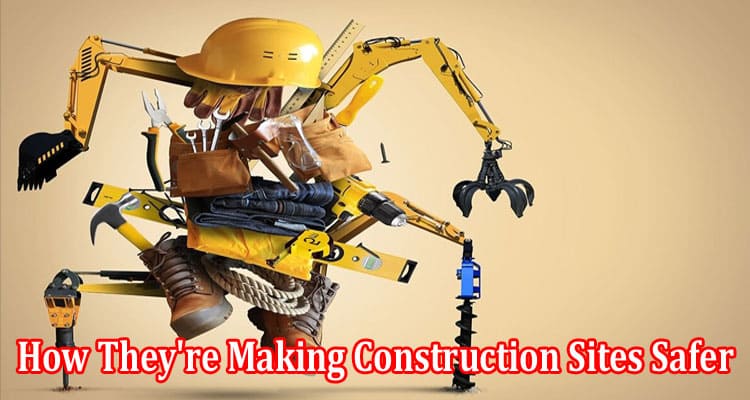Traditionally characterized by intense physical labor and a hands-on approach, the construction industry is on the brink of a major transformation. Integrating robots into construction sites is not merely a futuristic concept but a significant leap forward in ensuring safety and efficiency. This article delves into how autonomous construction robots reshape construction sites into enhanced safety zones.
Robotic Innovations Enhancing Safety
Automating Risky Tasks
Several tasks pose significant risks to workers in the construction world, such as working at heights, operating heavy machinery, or performing repetitive motions. Introducing robots to handle these dangerous tasks is a vital step towards enhancing safety. Robotic arms, for instance, are now used for lifting heavy materials and performing installations with precision, greatly reducing the physical burden on human workers. Furthermore, these robots can work in hazardous conditions where human safety would be compromised, such as in extreme temperatures or toxic atmospheres, thereby ensuring continuous progress without risking human health.
Drones for Surveillance and Inspection
Drones have become indispensable in modern construction sites, primarily used for site surveillance and structural inspections. They offer a bird’s-eye view, enabling site managers to identify and mitigate potential hazards before they escalate into accidents. These unmanned aerial vehicles are particularly effective for inspecting difficult or dangerous areas for humans to access, such as high-rise structures or unstable terrain. Additionally, drones equipped with thermal imaging can detect structural issues invisible to the naked eye, further enhancing the safety and integrity of construction projects.
Exoskeletons for Worker Support
Robotic exoskeletons represent a significant breakthrough in construction safety and efficiency. These wearable robotic systems enable workers to lift heavy objects with increased strength and endurance, drastically reducing the risk of injuries. Not only do they enhance the workers’ physical capabilities, but they also contribute to reducing fatigue, allowing for longer and more productive work periods. These exoskeletons are designed to be intuitive and user-friendly, ensuring they complement rather than complicate the worker’s tasks. The psychological benefits of such support are also noteworthy, as workers feel more secure and capable, leading to improved morale and job satisfaction.
Enhanced Precision and Quality Control
The incorporation of robots in construction greatly contributes to the precision and quality of work. Automated machines and robotic arms can execute tasks with accuracy that is challenging for humans to achieve consistently. This precision is crucial in ensuring that structures are built correctly and safely, reducing the likelihood of future structural issues. Robots can efficiently perform tasks like bricklaying, material cutting, and even large-scale 3D printing with unmatched precision. This speeds up the construction process and significantly lowers the margin of error, leading to safer, more reliable structures. Additionally, the use of robots in quality control processes ensures consistent adherence to standards, further enhancing the overall safety and longevity of construction projects.
Robots and Workforce Training
Enhancing Skill Sets
The integration of robotics into construction is reshaping the workforce, demanding new skills and competencies. Workers are now being trained to operate and interact with these machines, an evolution that is not replacing human labor but rather augmenting it. This shift is fostering a new generation of tech-savvy and safety-conscious construction professionals. The training programs focused on robotics equip workers with the necessary technical skills and emphasize the importance of safety protocols and efficient collaboration with robotic systems. This upskilling is creating a more dynamic and versatile workforce prepared to tackle the challenges of modern construction with innovative solutions.
Creating a Collaborative Environment
The coexistence of humans and robots on construction sites fosters a new era of collaboration. This partnership is pivotal in creating a work environment where safety is the cornerstone. Training programs are now focused on teaching workers how to effectively interact with robots, ensuring a harmonious integration of human intuition and robotic efficiency. Robots on construction sites also encourage a mindset shift among workers, from viewing robots as tools to seeing them as team members. This shift is crucial in maximizing the potential of robotic technology in construction, leading to safer, more efficient, and more innovative construction practices.
The Future of Construction Safety
Continuous Innovation
The field of construction robotics is in a state of constant evolution, with each day bringing new advancements and possibilities. This ongoing innovation is steadily pushing the boundaries of what’s possible in construction safety and efficiency. Future developments, such as AI-driven predictive analytics for accident prevention and autonomous robots capable of navigating complex construction sites, hold immense promise. These advancements are not just technical feats; they are steps towards creating construction sites that are efficient, productive, and inherently safe.
Sustainable and Safe Construction Practices
The integration of robotics in construction is also a stride towards sustainability. With their efficiency and precision, robots minimize waste and optimize resource use, making construction sites more environmentally friendly. The emphasis on safety, fostered by robotic technology, is creating a paradigm shift in the industry. Construction practices are evolving from being reactive in terms of safety measures to being proactive, with an aim to prevent accidents before they occur. This proactive approach improves safety standards and contributes to a more responsible and sustainable construction industry.
Conclusion
The advent of autonomous construction robots is a defining moment in the industry’s journey toward safety and efficiency. By undertaking high-risk tasks, enhancing the precision of construction work, and elevating the workforce’s skill sets, these technological marvels are setting new benchmarks in construction safety. The role of robots in construction is a testament to the industry’s commitment to innovation, safety, and sustainability, marking a new era of construction that is smarter, safer, and more efficient.




